
(Italian) Boots on the (Great) Plains
By: Tom Frascella MAY 2013
As our history section progresses we find we are approaching the beginning of the mass immigration of Italians to the U.S. I identify this period as starting around 1850. Specifically the immigration trend begins with the collapse of the 1848 Carbonari rebellion. I am looking forward to discussing some facts relating to this early phase of immigration and thought the article that follows may help set the table for such a discussion.
To start, some basic questions about the immigration.
Q. How many Italians came to the U.S. as immigrants between
1850 and 1930?
A. It is estimated that 4.5 million came about 80% from southern Italy.
Q. Why pick 1850 as a starting point?
A. Because between 1492 and 1800 only about 10,000 arrived and very few stayed.
Between 1800 and 1850 again about 10,000 came with about 50% staying, it is
not until 1850 that 10,000 arrived in a single decade and those numbers rose per decade thereafter.
Q. Approximately how many Italians arrived in the U.S. in the first several decades after 1850?
A. 1850-1860---------------10,000
1860-1870---------------20,000
1870-1880---------------45,000
Q. Who were these individuals? What were they like? Why did they come?
A. As individuals they were a diverse group. The Italian peninsula was experiencing major political shifts and strife in the 1850’s and 1860’s. The one thing that the Italian immigrant had in common was that the Italian political shifts triggered, directly or indirectly their need to leave their native regions. Thus the U.S. government regarded and classified them as political refugees up until 1880.
I think a good way to discuss the character of these early Italian immigrants is by citing examples. In the following article which I have titled “Italian Boots on the Great Plains” two early Italian immigrants are profiled. I chose this approach because both the U.S. and Italian history have largely made this early group invisible. To demonstrate that they were indeed here and active I have chosen to write about two who became comrades of circumstance and of arms in both Italy and the U.S.
These young men born on a divided Italian peninsula, both fiercely patriotic to the idea of Italian independence, became military heroes of the Unification movement a decade apart. However, neither found a home in a united Italy. Both then immigrated in the mid 19th century to the U.S. finding a nation also divided. Both men became fiercely patriotic to the Union. Once again both men became military heroes of the U.S. army. Yet their military exploits are largely unrecognized as those originating with Italian Americans.
To start this article I would say that two men could hardly be found in Italy who were so different in background from each other and more improbably, their lives directly connect not in Italy but on the Great Plains’ wilderness of 19th United States.

Carlo De Rudio (1832-1910)

Carlo De Rudio U.S. Army
Carlo De Rudio was born in 1832 in Belluno Italy a town just north of Venice. He was born the second son of Count De Rudio a wealthy northern Italian landowner whose family traced their noble lineage back to the 16th century. Carlo was raised to a life of wealth, privilege, and social status. At the age of 14 Carlo was enrolled in a private military school run under the auspices of the Austrian Military. Austria controlled much of northern Italy. In 1848 small groups of Carbonari in many Italian cities attempted to throw off foreign rule. Carlo dropped out of military school at 16 to enlist in the “Young Italy” patriot cause. His talent and bravery soon came to the attention of the commander of the military arm of the rebellion Giuseppe Garibaldi. Carlo became a member of Garibaldi’s personal staff. He remained in this position until captured by the French just prior to Garibaldi’s defeat in central Italy in the early 1850’s. Garibaldi’s defeat by the French was a bitter pill to accept in that France’s new leader, Napoleon III had been a member and promoter of the “Young Italy” movement. With Garibaldi’s defeat most of the general’s staff faced exile or execution. Carlo although imprisoned by the French he escaped. This was the first of many narrow escapes in young Carlo’s life. At first he tried to return to his home in northern Italy. However, individuals like Mazzini, Garibaldi and young Carlo were known leaders and as a result were all tried by military tribunals in absentia. Austria placed a sentence of death on Carlo and in 1853 for charges stemming from his desertion from the Austrian military and subsequent support of the rebellion. He sought refuge in Switzerland and France was recaptured but with Mazzini’s help was able to obtain political asylum in England.
Carlo carved out a new if restless life in exile for himself. He met a young English women, fell in love and married. However he continued to meet with other Italian exiled patriots who advocated for Italian nationalism. By the mid 1850’s he became involved with some of these men in a plot to assassinate the head of the French government Napoleon III. Italian Carbonari regarded Napoleon III, once a Carbonari himself, as a traitor to the cause. Carlo together with several others actually attacked Napoleon hurling grenades which killed eight bystanders but did not injure Napoleon. Four Italians were captured and tried. Two of the men received death sentences and two including Carlo received life sentences to the French penal colony “Devil’s Island” a living death sentence from which escape was deemed impossible.
However, the French appear to have a very bad record of being able to hold on to young Carlo. After about two years of hard labor at the penal colony Carlo did the impossible and escaped from Devil’s Island. He and eleven other inmates stole a fishing boat and made a 1,100 mile open sea voyage to an English protectorate. They made the trip without navigational equipment. From there he made his way back to England and his wife by 1860. Of course the act of escape from the French penal colony earned Carlo his second conviction in absentia and his second death sentence, this time from France. While there was support in England for the Italian national cause, the assassination attempt was a political embarrassment for both England and the Unification efforts in Italy. Carlo found that he could not find protection against France’s pressure to extradite. Carlo was advised by Mazzini that his best chance of survival was to flee to the United States where he might get lost in the vastness of the country.
In 1863 Carlo De Rudio and his wife immigrated to the U.S. with a letter of introduction to newspaperman Horace Greeley. Greeley grasped fully the international political implications that would confront the U.S. which was in the midst of the Civil War, by protecting Carlo as a refugee. His advice to the 31 year old De Rudio was not to go west but to enlist in the U.S. Army. In 1864 Carlo De Rudio enlisted in a New York regiment as a private.
Over the next year Carlo found himself in some of the bloodiest battles of the American Civil War. In those battles he fought with courage and distinction earning many awards for valor and ultimately a battlefield commission. As a 2nd Lt. De Rudio was assigned in 1865 to the 2nd Colored Regiment which was stationed in Key West Florida. Finding that he liked the Army and that it afforded him and his family some degree of political protection Carlo spent the better part of the next five years, until 1869, as a 2nd Lt.. In 1869 37 year old Carlo (Charles) De Rudio transferred to a cavalry regiment forming on the Great Plains of the U.S. At 37 he was one of the oldest officers in the unit. Yet he found himself beginning an assignment that would have been challenging even for a much younger officer. In 1875 De Rudio was promoted to 1st Lt. and placed in charge of Company E of the 7th U.S. Cavalry.
Here I will leave off writing about Carlo briefly and begin the story of the second Italian the article profiles.

Giovanni Martini (1852-1922)

Giovanni Martini U.S. Army
Giovanni Martini was born in Sala Consilina, a small town in the mountains east of Salerno, in the part of southern Italy traditionally known as Lucania in 1852. This was about the same time as 20 year old Carlo De Rudio was going into exile in England. Giovanni was the “natural” son of a small town local administrator. He grew up estranged and unrecognized by his father. As a result of the circumstances of his birth he was poor, without family name or opportunity to improve his financial or social position. With no prospect of improvement and hearing the national call for Unification Giovanni decided to enlist with the Italian forces fighting for Unification under Garibaldi in northern Italy in 1866. He was just fourteen year old and enlisted as a drummer boy, an unarmed battlefield signalman. He remained in the Italian army until 1871 and saw the achievement of the national State of Italy. In 1871 he returned to his hometown in Southern Italy where he found local prospects and opportunities had diminished rather than improved. In 1872 he decided to immigrate to the United States where he heard jobs and opportunities were readily available. Upon arriving in New York instead of opportunity he found a country entering into the worse economic depression in its history. He also found a rising anti-immigrant/ anti Italian social climate. For two years part time or day labor was the only work he managed to obtain. In 1874 he decided to go back to the only skill set he had developed and enlisted in the U.S. Army. At the time of his enlistment his name was recorded on his enlistment papers as John Martin, rather than Giovanni Martini.
John Martin received both his basic training and his advanced training as a Cavalryman/bugler in New York State. In 1875 John Martin received his orders to report to a U.S.7th Cavalry stationed on the Great Plains.
So in 1875 forty three year old 1st Lt. Charle De Rudio and Private John Martin both found themselves on duty in the American West with the U.S. 7th Cavalry under the direct command of Col. George Armstrong Custer.
History tells us that on June 25th and 26th 1876 the U.S. 7th Cavalry had a date with destiny at the Little Big Horn River. On the 25th of June both De Rudio and Martini were among the roughly 500 U.S. Troopers under Col. Custer’s direct command. In all the 7th had between six and twelve troopers of Italian birth in June of 1876.
Interestingly, the majority of Custer’s troopers of Italian descent served in the same unit. Part of the American military experience going all the way back to Jefferson’s Presidency was that Italians were considered highly skilled in the arts, especially the musical arts. As a result it was common to find men of Italian descent in the military with duties that included being in the unit’s military band. This was true under Custer’s command with the majority of the members of the regimental band being of Italian descent. In fact the band director’s last name was Lombardi and he is identified as having been born in the Provence of Naples Italy.
As Col. Custer approached the fateful day of June 25, 1876 it is known that he gave a series of commands which divided his force. The first division was when he separated his main body from his supply train to allow for faster movement of his forces. He left a unit of troopers behind to guard the wagons as his main body pushed forward. Had the Native American force discovered the wagons the meager force of troopers left behind to defend the wagons would have offered no challenge. Fortunately they were not discovered and survived. Among the troopers left on guard was the entire regimental band.
As Custer’s force approached the Little Big Horn he again divided his forces in three. He retained about half his force. He divided the other half again one part under Major Reno with orders to attack any force of Native Americans encountered and the other a scouting group under the command of Captain Benteen. On the day of the battle Lt De Rudio was originally assigned command of Company E which remained under Custer. However Custer switched Company assignments and placed De Rudio in command of Company A which fell in Major Reno’s group. The only trooper left of Italian descent that remained directly with Custer was Custer’s bugler John Martin.
When Custer spotted what he deemed to be the major Native American encampment he hastily drew up an order calling up Reno’s and Benteen’s forces in support. Custer passed the message to John Martin giving him responsibility to find Reno’s command about four miles away and deliver the message. Martin set off on his message run alone. On his mission he first encountered a small number of troopers bringing up the rear with a mule train carrying reserve ammunition. While delivering Custer’s order to them to join up, Captain Benteen arrived with three companies and also received the order.
However, before Benteen could respond the sound of the first engagement was heard and the troopers under Benteen’s command moved to the direction of the exchange. From a ridge Benteen saw that Reno’s forces were under attack and retreating to high ground taking up defensive position. Benteen made the command decision to go to support Reno’s position as he was technically under Reno’s direct command. Martin remained attached to Benteen’s units in support of Reno still under orders to deliver Custer’s orders to Reno.
In the initial encounter between Reno and the attacking Native American force, Lt. .De Rudio’s Company A was charged with fighting the rear action allowing Reno to achieve high ground. During that engagement De Rudio’s horse was shot out from under him and on foot he became isolated from Reno’s forces. Stranded and on foot surrounded by enemy he was able to aid another wounded trooper and together the two eluded capture for the rest of the day. De Rudio would later credit the fact that against orders he had brought his saber with him and was able to defend himself without giving away his position.
Benteen joined up with Reno secured their position and then they heard the sound of Custer’s engagement. They did leave their defensive position but they were unable to reach Custer. Their combined unit only got as close as a bluff several miles away. On achieving the bluff they saw the final moments of Custer’s engagement. Recognizing that it was too late to aid Custer and again coming under fire they retreated to the previous high ground where they successfully withstood several assaults. After dark Lt. De Rudio was able to rejoin Reno’s force bringing in a wounded trooper.
The following day the Reno’s command was relieved by other U.S. Army units arriving on the field.
Having survived the battle of the Little Big Horn both Lt. De Rudio and Private Martin continued in the Army and continued in the Indian War campaign until the eventual surrender of Sitting Bull. Lt. De Rudio remained in the Army and retired in 1896, a Major at the age of sixty-four. After retirement he together with his family settled in Pasadena California and later Los Angeles.
Private Martin also continued in the military until his retirement with the rank of Sergeant in 1904. During his career he also married and had several children. In later life he resided with one of his daughters in Brooklyn N.Y. where he died of complications after being struck by a truck in 1922. He is buried in Cypress Hills Cemetery.
Retired Major De Rudio certainly earned a restful retirement given the remarkable and colorful life he had lived. However there is a final chapter to his story. In retirement in 1908 he was approached by an historian who interviewed him concerning his involvement in the assassination attempt on Napoleon III. In the interview De Rudio named prominent Italian Statesman Francesco Crispi as having participated in the attempt. His assertions caused quite an international scandal with denials given at the highest levels of Italian government as Crispi had been an Italian Prime Minister. So controversy followed him throughout his life.
In any event, De Rudio died of natural causes in bed surrounded by his wife and family in 1910. Per his instructions his body was cremated and the ashes buried in the cemetery at the Presidio in San Francisco.
When we exam the experiences of these two early Italian immigrants, we see that the turbulence and volatility of the Italian political, economic and geographic landscape is very much a part of their individual histories. This appears true for most of those immigrating early. But we are also going to see their courage, strength and determination to succeed in the face of long odds is also a trait that they carried with them. The two men profiled above are just examples of spirit that was very much a part of these early pioneers that laid down the first steps on the path that millions would follow. In closing I would point out that by the mid 1870’s when the two that I have written about above were fighting on the Great Plains all four of the major communities of San Felese, New York, Trenton, Newark and Buffalo had already started.
© San Felese Society of New Jersey